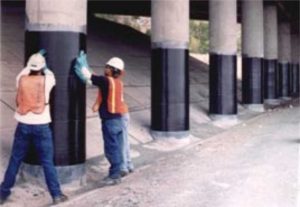SEISMIC RETROFITTING TECHNIQUES
Conventional Strengthening Methods
Conventional retrofitting methods include addition of new structural elements to the system and enlarging the existing members.
Addition of shear walls and bracings shown in Fig. 1(a) is the most popular strengthening method due to its effectiveness, relative ease, and lower overall project cost compared to column and beam jacketing shown in Fig. 1(b) and (c), respectively. Relative effectiveness of various wall and bracing configurations are compared in Fig. 1(a). From this figure, it is seen that post-cast shear walls and steel braced frames are the most effective strengthening techniques. Although the latter is more effective due to its much higher ductility, post-cast concrete shear walls are the most commonly applied method due to their lower cost and familiarity of the construction industry with the method. Design of additional shear walls is performed to resist a major fraction of the lateral loads likely to act on the structure. This reduces the demand on the beams and columns, hence increasing their safety. Those still likely to be over stressed are strengthened through concrete or steel jacketing, which are relatively more laborious applications.
Above figure shows applications of various conventional strengthening methods such as post-cast shear wall (a), additional foundation to support the shear walls to be constructed around the stairs (b), concrete jacketing of a column (c), and addition of column members to remedy vertical irregularities (d). The main research need associated with conventional strengthening methods is optimisation of the retrofit design to achieve a satisfactory structural performance level at a minimum cost based on reliably characterised seismic demand and structural capacity.
Fibre Reinforced Polymer (FRP)
Current research on advanced materials in civil engineering is mainly concentrated on high performance concrete and steel, and fiber reinforced plastic (FRP) composites. FRP composite materials have experienced a continuous increase of use in structural strengthening and repair applications around the world in the last fifteen years. High specific stiffness and specific weight combined with superior environmental durability of these materials have made them a competing alternative to the conventional strengthening methods. It was shown through experimental and analytical studies that externally bonded FRP composites can be applied to various structural members including columns, beams, slabs, and walls to improve their structural performance such as stiffness, load carrying capacity, and ductility.
READ MORE
SEISMIC RETROFITTING
BASE ISOLATION
SUPPLEMENTAL ENERGY DISSIPATION AND ENERGY CONTROL
EFFECTS OF SEISMIC RETROFITTING ON STRUCTURAL PERFORMANCE
Seismic retrofitting techniques, Seismic retrofitting techniques, Seismic retrofitting techniques, Seismic retrofitting techniques, Seismic retrofitting techniques, Seismic retrofitting techniques, Seismic retrofitting techniques, Seismic retrofitting techniques, Seismic retrofitting techniques, Seismic retrofitting techniques


